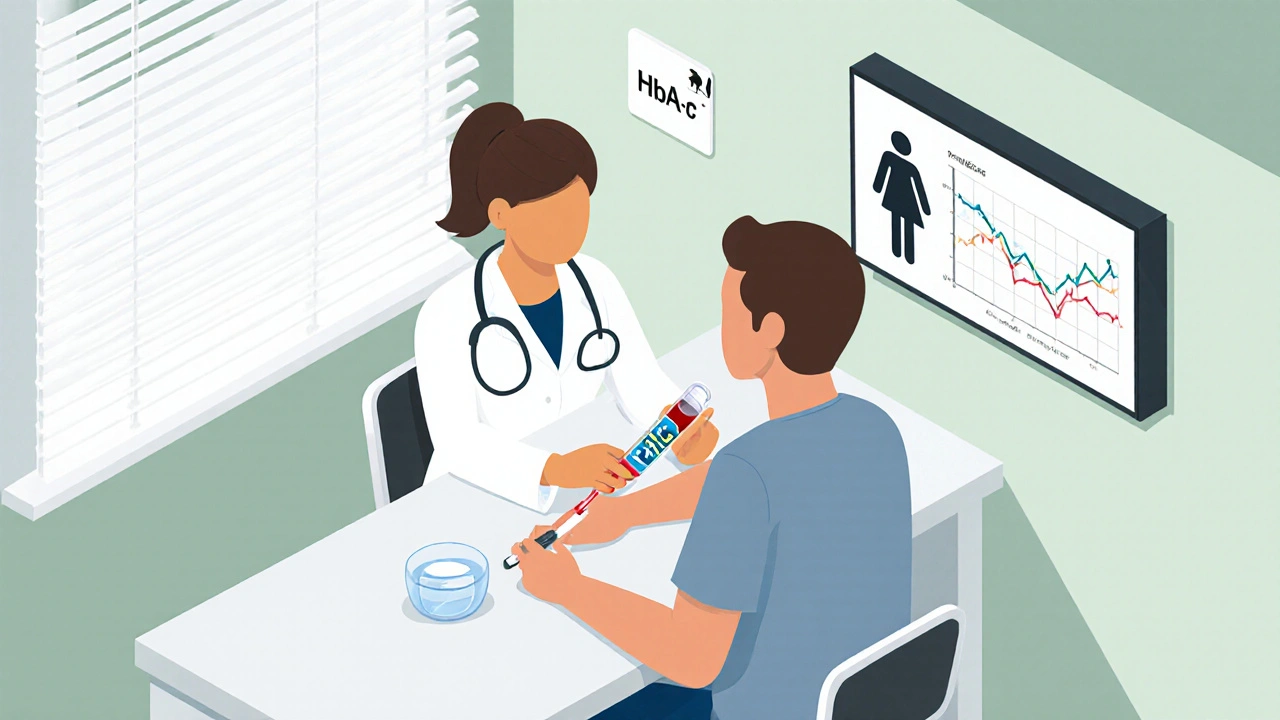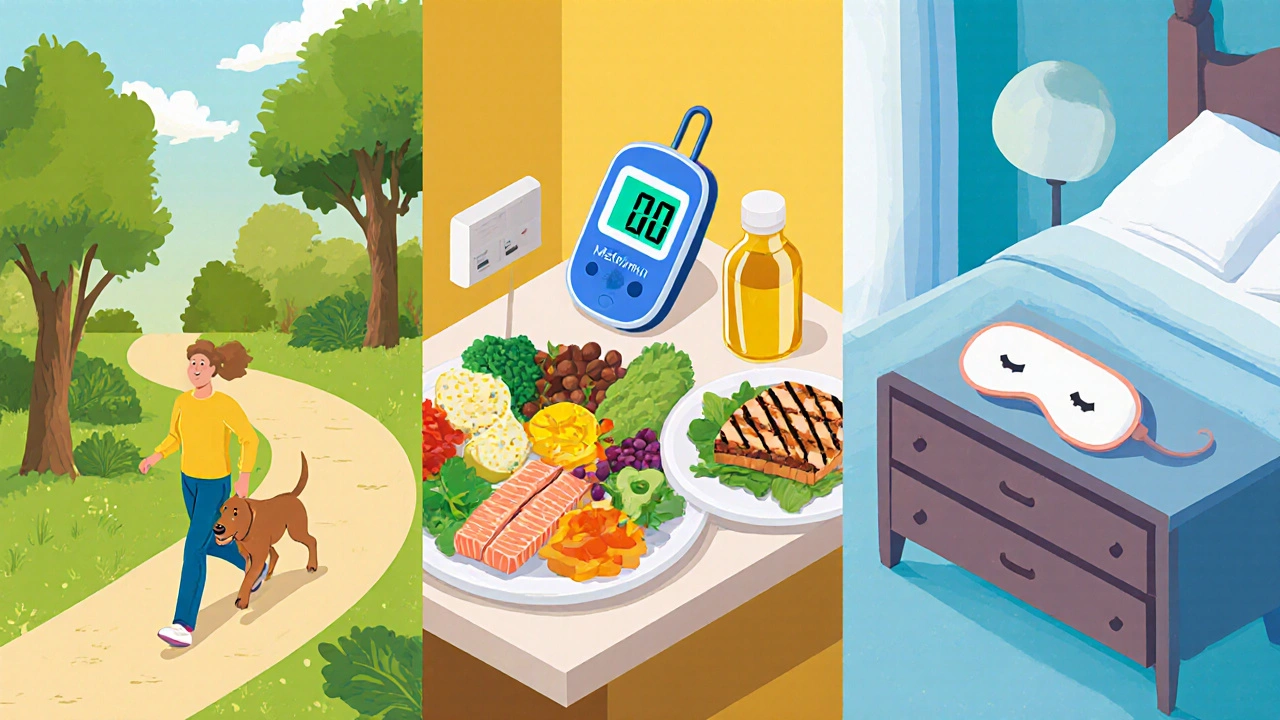HbA1c to Estimated Average Glucose (eAG) Converter
HbA1c to eAG Converter
Convert your HbA1c percentage to estimated average glucose (eAG) to better understand your blood sugar control over the past 2-3 months.
Your result will appear here after calculation
What this means:
Normal range (HbA1c < 5.7%): Estimated average glucose is below 117 mg/dL
Prediabetes (HbA1c 5.7-6.4%): Estimated average glucose is 117-140 mg/dL
Diabetes (HbA1c ≥ 6.5%): Estimated average glucose is ≥ 140 mg/dL
Key Takeaways
- Type 2 diabetes develops when the body’s cells stop responding properly to insulin.
- Major risk factors include excess weight, sedentary lifestyle, and family history.
- Typical symptoms are increased thirst, frequent urination, fatigue, and blurry vision.
- Doctors confirm the disease with fasting glucose, HbA1c, or oral‑glucose‑tolerance tests.
- Management combines lifestyle changes, regular monitoring, and often medication such as metformin.
If you’re looking for the basics, type 2 diabetes is the most common form of diabetes worldwide.
What is Type 2 Diabetes?
When we talk about Type 2 Diabetes is a chronic metabolic disorder marked by elevated blood‑sugar levels because the body’s cells become resistant to insulin and the pancreas cannot produce enough to overcome that resistance. Unlike the insulin‑dependent form that usually appears in childhood, this type tends to develop in adulthood, although younger people are increasingly affected.
Root Causes: Why Does It Happen?
At the heart of the problem is Insulin resistance, a condition where muscle, fat, and liver cells ignore the signal from insulin. When cells don’t take up glucose, the pancreas pumps out more insulin, and eventually it can’t keep up.
Several factors drive insulin resistance:
- Obesity: Excess visceral fat releases hormones that blunt insulin’s effect.
- Genetics: Families with a history of diabetes pass on genes that affect how the body handles glucose.
- Sedentary lifestyle: Lack of regular movement reduces muscle glucose uptake.
- Unhealthy diet: High‑calorie, low‑fiber, and sugary foods spike blood sugar repeatedly.
Another precursor is Pre‑diabetes, a state where fasting blood‑sugar is higher than normal but not yet in the diabetic range. Without intervention, many people progress to full‑blown Type 2 Diabetes within a few years.

Typical Symptoms to Watch For
Symptoms often creep in slowly, making early detection tricky. Below is a quick snapshot of what most people notice.
| Symptom | What Triggers It |
|---|---|
| Increased thirst (polydipsia) | Kidneys try to flush out excess glucose, pulling water from the body. |
| Frequent urination (polyuria) | More water drawn into urine as glucose is eliminated. |
| Unexplained weight loss | Cells can’t use glucose for energy, so the body burns fat and muscle. |
| Fatigue | Energy production drops when glucose stays in the bloodstream. |
| Blurry vision | Fluid shifts change the shape of the eye’s lens. |
| Slow‑healing cuts | Poor circulation and high glucose impair wound healing. |
Because the signs are subtle, routine screening is crucial, especially if you have any risk factors.
How Doctors Diagnose the Condition
Diagnosis relies on measuring blood glucose levels in a few different ways:
- Fasting Plasma Glucose (FPG): After an overnight fast, a level≥126mg/dL (7.0mmol/L) confirms diabetes.
- HbA1c test: This measures the average glucose over the past 2‑3 months. An HbA1c result≥6.5% indicates diabetes.
- Oral Glucose Tolerance Test (OGTT): After drinking a sugary solution, a 2‑hour blood draw≥200mg/dL confirms the disease.
Doctors may also screen for complications-eye exams for retinopathy, urine tests for kidney damage, and foot checks for neuropathy.

Managing Type 2 Diabetes: A Practical Roadmap
Effective control blends three pillars: monitoring, lifestyle modification, and medication.
1. Monitoring Your Numbers
Self‑testing with a glucometer helps you see how meals, activity, and stress affect blood glucose. Aim for fasting levels below 100mg/dL and post‑meal peaks under 180mg/dL, unless your doctor sets a different goal.
2. Lifestyle Modification
Weight loss of just 5‑10% can dramatically improve insulin sensitivity. Focus on:
- Balanced diet: Plenty of non‑starchy vegetables, whole grains, lean protein, and healthy fats. The Mediterranean pattern is a proven winner.
- Regular exercise: At least 150minutes of moderate aerobic activity (like brisk walking) plus two strength‑training sessions each week.
- Sleep hygiene: 7‑9hours nightly reduces cortisol spikes that worsen insulin resistance.
- Stress management: Mindfulness, yoga, or simple breathing exercises lower blood‑sugar spikes caused by adrenaline.
3. Medication Options
When lifestyle alone isn’t enough, doctors usually start with Metformin. It lowers glucose production in the liver and improves insulin sensitivity without causing weight gain.
Other drug classes-GLP‑1 agonists, SGLT2 inhibitors, or DPP‑4 inhibitors-may be added later, especially if you have heart or kidney concerns. Your physician will tailor the regimen based on your overall health.
Frequently Asked Questions
Can Type 2 Diabetes be reversed?
Many people achieve normal blood‑sugar levels through sustained weight loss, diet, and exercise. While the disease may stay dormant, ongoing monitoring is still advised.
How often should I get my HbA1c checked?
If your diabetes is well‑controlled, an HbA1c test every 6months is typical. Your doctor might schedule more frequent checks during medication changes.
Is it safe to exercise if I have high blood sugar?
Mild‑to‑moderate activity is usually fine, but if your glucose is above 250mg/dL with ketones present, hold off and seek medical advice.
What foods should I avoid?
Limit sugary drinks, white bread, pastries, and large portions of starchy sides. Opt for whole‑grain alternatives and fiber‑rich vegetables instead.
Does Type 2 Diabetes affect life expectancy?
When well‑managed, people with Type 2 Diabetes can live as long as those without the condition. Complications arise mainly from poor control.
Next Steps
If you suspect you have any of the symptoms listed above, schedule a blood‑sugar screening with your GP. Keep a log of your meals, activity, and how you feel-this data helps the doctor pinpoint the right tests.
Remember, Type 2 Diabetes is a manageable condition. With the right mix of awareness, lifestyle tweaks, and professional care, you can keep your numbers in check and enjoy a healthy life.
Lauren Sproule
October 17, 2025 AT 12:26If you’re lookin to start a better wokrout routine, try swaping sugary drinks for water and aim for a short walk after meals. Keeping a simple food log can show you where the extra carbs hide and it doesn’t have to be a big chore
CHIRAG AGARWAL
October 18, 2025 AT 17:06Well this article repeats the same old stuff you can find on any health site. It’s like reading a recycled brochure, nothing new to actually help anyone.
genevieve gaudet
October 19, 2025 AT 22:16When we contemplate the notion of disease, it’s almost like a mirror reflecting our cultural habits. In many societies, the shift from communal meals to fast‑food convenience has rewired our bodies. The modern diet, high in refined sugars, subtly reshapes our metabolic pathways while we chase convenience. It’s fascinating how a simple change in food culture can ripple into a global health phenomenon. Remember, awareness of these patterns is the first step toward collective healing.
Patricia Echegaray
October 21, 2025 AT 03:26Don’t be fooled-big pharma loves the idea of chronic disease. They push meds like Metformin while keeping the public fed on sugar‑laden lies. It’s a grand scheme to keep us dependent, all under the guise of "science". The truth is hidden behind glossy ads, and the real cure lies in rejecting junk food, not swallowing pills.
Samantha Oldrid
October 22, 2025 AT 10:00Oh great, another post telling us to eat kale-thanks for the groundbreaking insight.
Roberta Makaravage
October 23, 2025 AT 16:33Let’s get real: the fundamentals are simple. Eat whole foods, move your body, and monitor your numbers. 🍎🏃♀️ Your pancreas can only do so much if you keep feeding it processed junk. And if you think medication alone will save you, you’re missing the bigger picture of lifestyle sovereignty. 🌟
Miriam Rahel
October 25, 2025 AT 00:30While the article provides a satisfactory overview, it omits a thorough discussion of the socioeconomic determinants that influence disease prevalence. Moreover, the recommendation to "just exercise" disregards barriers faced by lower‑income populations. A more nuanced approach would consider policy interventions alongside personal responsibility.
Malia Rivera
October 26, 2025 AT 07:26Our nation’s strength lies in its people’s willingness to take charge of their health. By adopting a disciplined regimen-balanced diet, regular cardio, and the occasional patriotic jog-you honor both your body and your country. Remember, the American spirit thrives on self‑reliance, not on reliance on endless prescriptions. The land of the free truly means freedom from preventable disease. So lace up those shoes, choose a low‑sugar breakfast, and march forward like the resilient citizens we are.
lisa howard
October 27, 2025 AT 16:46Listen up, folks, because this is the story you didn’t know you needed. Imagine waking up at 5 am, the alarm screaming like a siren, and you’re already on the treadmill, sweat dripping, heart pounding like a war drum. You think you’re just burning calories, but in reality, you’re battling the invisible foe that lurks in every sugary crumb. The blood‑sugar spikes are like tiny explosions, and every extra pound of visceral fat is a secret agent feeding the resistance. You’ve heard the doctors talking about "monitoring"-well, think of it as your personal battlefield map, showing where the enemy is strongest. The next time you stare at a donut, picture it as a ticking time‑bomb, waiting to detonate inside you. And when the doctor says ‘metformin,’ imagine a shield forged in the labs of modern science, yet still not as potent as the ancient armor of disciplined lifestyle. The Mediterranean diet? It’s not just a fad; it’s a strategic alliance with nature, each olive oil drizzle a treaty of peace. When you nap, remember the body repairs itself in those quiet hours; neglect that, and you’re handing victory to the sugar‑horde. Stress, the silent assassin, sneaks in with the daily grind, releasing cortisol that further fuels the fire. So you must become a warrior of habits-mindful breathing, yoga, the ritual of daily movement. Each step, each healthy meal, is a siege line you build against the encroaching chaos. And if you ever feel the weight of doubt, recall the countless ancestors who survived harsher trials without the crutch of pills. Their legacy lives in every mindful bite you take. In the end, the story isn’t about a disease; it’s about reclaiming sovereignty over your own body. Rise, take up the mantle, and let the world see a healthier, stronger you.
Cindy Thomas
October 29, 2025 AT 02:06Wow, that was a marathon of words! While the drama is entertaining, the core takeaway is simple: cut carbs, stay active, and keep an eye on your glucose. 😐
Kate Marr
October 30, 2025 AT 05:53America will always rise above health scams 🇺🇸
James Falcone
October 31, 2025 AT 12:26Exactly, nothing beats good old American grit and a solid diet.